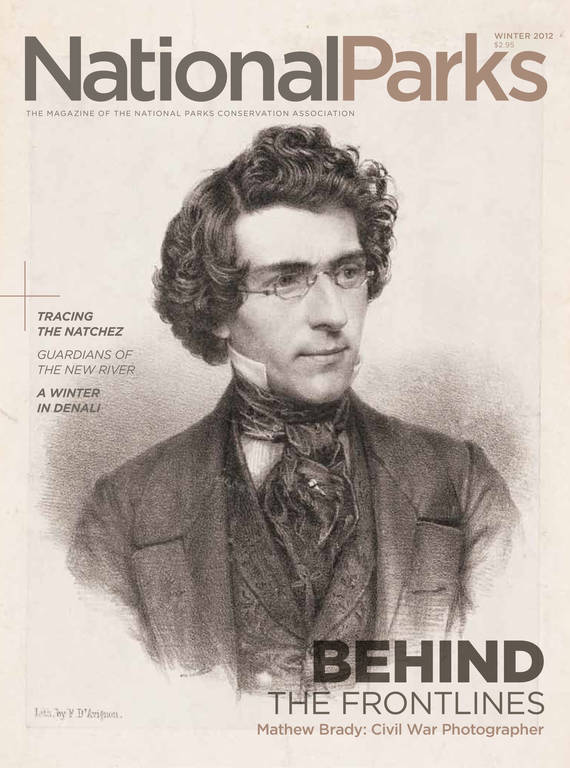Winter 2012
A Shoreline Rescue
The National Park Service fights to bring Great Lakes’ piping plovers back from the brink.
In the morning hours, when the lake and the sky are the same soft gray, Alice Van Zoeren steps among the small stones marking the high waterline at Sleeping Bear Dunes National Lakeshore in Michigan. Van Zoeren walks this route almost every day from late April to June, scanning the beach for signs of newly arrived piping plovers—but this time, the scene looks different: A late-spring storm has repositioned the lakeshore’s cobbles. To most visitors, the disturbance would go unnoticed. But to Van Zoeren, who has been monitoring piping plovers here for the last eight years, it’s as if someone came by and rearranged the furniture without asking permission. Once the plovers build their nests and lay their eggs amid the stones, such a seemingly innocuous event can have disastrous consequences for the small, pale shorebird with bright orange legs.
“The nests are really just small indentations among the cobbles where the stones can provide camouflage for the eggs,” says Van Zoeren, a researcher with the Great Lakes Piping Plover Conservation Team—a coalition led by the U.S. Fish and Wildlife Service. “It can be a very vulnerable position.”
Three distinct populations of piping plovers make their homes in North America, and all were federally listed under the Endangered Species Act in 1986. They are the Atlantic Coast and the Northern Great Plains, listed as threatened, and the Great Lakes, listed as endangered. Birds from all three regions migrate to the Gulf Coast and the southern Atlantic Coast, where they winter together. Researchers and volunteers have focused their efforts largely on breeding grounds where they can intervene to protect the next generation of birds from predators and other disturbances.
The Great Lakes population remains the most fragile. When these birds were declared endangered 25 years ago, only 17 breeding pairs remained. Since then, the population has grown to 54 breeding pairs, but the birds still sit on the edge of extinction because of low fledgling rates—only 75 chicks survived to fly south in 2011—and continued threats from coastal development, habitat loss, predation, and a range of other natural and human factors.
Human-driven growth and the associated impact on natural resources have changed the make-up of the local and regional ecosystems, in some cases causing population increases in predators like foxes, skunks, and raccoons that raid plover nests, says Sue Jennings, park biologist at Sleeping Bear Dunes.
At Sleeping Bear, park visitors and off-leash dogs also pose large risks to breeding plovers and nests. To combat these threats while allowing visitors to enjoy the dunes and the plovers, park staff created a plover-awareness campaign that encourages visitors to leash their pets and respect signs indicating nesting areas closed to human activities. “We’re managing for the birds and also managing for the human visitors,” says Jennings.
The measures have resulted in a higher number of successfully fledged birds at Sleeping Bear than in many other regional nesting sites. But the entire Great Lakes population remains incredibly vulnerable to a population-wide event, such as disease, which could devastate the birds. To earn their removal from the endangered species list, the population will have to hold steady with 300 individual birds for five consecutive years, says Jennings; in addition, each nesting pair would need to fledge one or two chicks per year on average.
Only one in four chicks survives to become a breeding adult, according to Francie Cuthbert, a professor at the University of Minnesota and an expert on shorebird populations and management. Recovery occurs very slowly with numbers like these, and the potential for pitfalls is rampant. If the population fails to grow, it may eventually lose genetic diversity, making it even more prone to failure.
To keep track of individual birds, mating pairs, and the fledglings that result, Cuthbert works with Van Zoeren, Park Service monitoring crews, and a larger team of volunteers and scientists to capture every plover hatched in the Great Lakes population, place leg bands on them, and release them. The work is delicate and exhausting, but it yields critical data that provide insight into the plover lifecycle; researchers say the hard work has far-reaching impacts.

National Parks
You can read this and other stories about history, nature, culture, art, conservation, travel, science and more in National Parks magazine. Your tax-deductible membership donation of $25 or more entitles…
See more ›In fact, three federally listed plant species—Pitcher’s thistle, Houghton’s goldenrod, and dwarf lake iris—have received increased protection because their habitat overlaps with lands mandated as critical plover habitat. The Lake Huron tansy and the Lake Huron locust, which have been designated as threatened species by Michigan but are not listed federally, have also benefited from plover recovery actions.
“The plovers are a flagship species for conservation and protection of special places,” says Cuthbert—such as shoreline throughout the Great Lakes, including portions of Whitefish Point and Vermillion Point on Lake Superior and habitat near Cross Village, South Fox Island, and Cathead Bay near Lake Michigan. This protection of the Great Lakes Coastal Living System is a core ideal of the plover-restoration team.
“Imagine walking along a lakeshore and not seeing shorebirds running back and forth in unison as the waves ebb and flow, not hearing the gulls, not seeing the plants and trees waving in the breeze,” says Jennings. “Each time we lose a bit of nature, we lose thousands of intricate connections that contribute to our humanity.”
About the author
-
 Aimee Lyn Brown Contributor
Aimee Lyn Brown ContributorAimee Lyn Brown is a freelance writer in Oregon. She spent her childhood in the Pacific Northwest, and made her first trip to Crater Lake National Park before she could walk.



